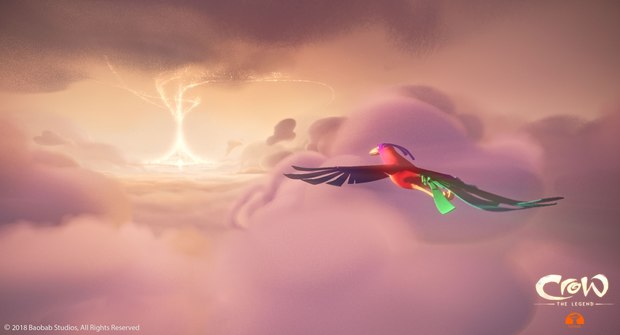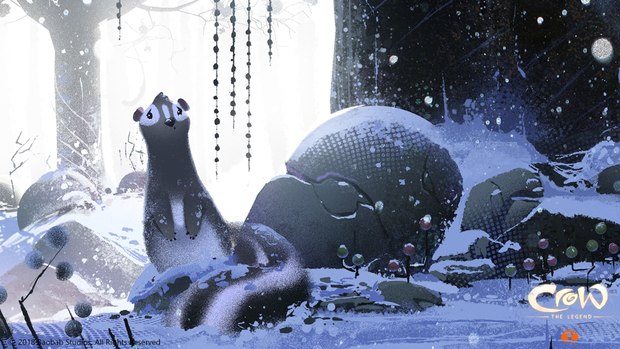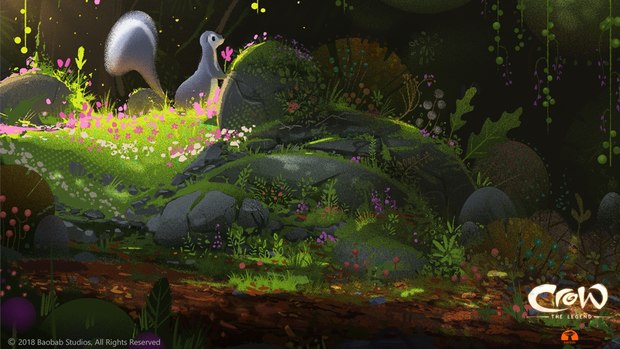Created using the Unity game engine, VR experience and accompanying theatrical short film written and directed by Eric Darnell and produced by Maureen Fan pushes real-time graphics to new heights.
Created in collaboration with multihyphenate talent John Legend, and featuring the voices of Diego Luna, Tye Sheridan, Constance Wu and Oprah Winfrey, Crow: The Legend pushes real-time graphics to new heights. The Annie Award-nominated project, produced by VR specialists Baobab Studios, the creators of the award-winning Asteroids! and Invasion!, is available as of November 15 on YouTube and in the Oculus Store.
Written and directed by Baobab co-founder Eric Darnell of Antz and Madagascar fame, and produced by Maureen Fan (The Dam Keeper), Crow: The Legend is the story of a group of animals tested by the forces of nature when the spirit of the seasons introduces the first-ever winter to their idyllic habitat. The virtual reality experience and accompanying theatrical short film features an original song by Legend, who, in addition to serving as executive producer, voices -- and sings in -- the title role.
With his colorful plumage and melodic voice, Crow is the most revered animal in all the forest. But when he is tasked with making an appeal to bring back warmer weather to a divine being dubbed “The One Who Creates Everything by Thinking” (voiced by Winfrey), he is forced to choose between himself and his fellow animals. Realizing he is their only hope, Crow ventures on an arduous trek that irrevocably damages his voice and stunning colors. And while Crow is initially embarrassed by his physical transformation, he ultimately learns that his act of self-sacrifice is far more beautiful and gratifying than his appearance.
Created using the Unity game engine, Crow: The Legend has a distinct storybook look and feel. It premiered at the Tribeca Film Festival, screened as an official selection at the Cannes NEXT VR film market, and opened the recent 10th anniversary edition of the CTN eXpo with a screening, panel and reception. Earlier this summer, it is also qualified for consideration in the 2019 Academy Awards animated short film race with a week-long daily theatrical run at the Laemmle Claremont 5 Theater in Los Angeles.
Darnell first encountered the story of the Crow after discovering he was part Native American, which led to a fascination with Native American storytelling. Understanding that the story may not necessarily be his to tell, Darnell enlisted Sarah Eagle Heart, CEO of Native Americans in Philanthropy, and Randy Edmonds, an elder of the Kiowa-Caddo tribe and founder of the National Urban Indian Council, to provide guidance, support, and their voices to the film in order to keep the legend as authentic as possible.
One of the most impressive aspects of the VR experience is how purely immersive it is. Providing true 360-degree environments, the VR version purposefully does not incorporate any distracting buttons or other controls. Instead, viewers wave their hands to interact with the experience, conducting the music of the universe, as it were.
“It’s interesting, some people want to play an active role in the experience as Crow goes through the seasons but other people want to be able to sit back and have the story wash over them,” Fan notes. “From the beginning, we planned to do it in both VR and 2D because we think that is the future of animation, where audiences can choose which format they want to experience things in.”
For the VR version of Crow, Darnell sought to make the interactive portions feel organic and intuitive. “So instead of pressing buttons and thinking, ‘What am I supposed to do?’ we wanted it to feel completely natural, like a natural extension of your hands, so when you wave flowers grow or the snow comes, depending on the environment,” Fan explains.
“It is natural. It’s like you’re magical, and all you have to do is gesture. It’s something we tested early on with the snow, and it was so immediately satisfying that we kind of knew that we were on to something,” Darnell adds. “And we’d seen people in other VR experiences stopping and, even though they had the headset on, trying to look at their controllers and figure out, ‘What am I supposed to push?’ And of course, when the viewer starts doing that kind of thing they’re not paying attention to the story.”
Baobab CTO Larry Cutler describes what he calls the “subtle tutorial-ization” incorporated throughout Crow to help guide users through the experience: “So you might get narrative cues, like ‘it’s time to wave your hands,’ but there are also other cues such as vibrations or effects like snow flurries and color shifts that work to make viewers aware of interactive features,” he says.
One of the biggest challenges the Baobab team faced in making Crow was developing what Darnell calls its “Storybook” look. The studio put in a great deal of effort to make the film look soft and cuddly, avoiding the hard-edged photorealism of a video game, which was difficult since the film was animated inside a video game engine.
“Real-time, obviously, is critical for VR, because we’re changing the animation on the fly based upon what the viewer does,” Darnell notes. “It’s one of the things that makes animation so great for VR. We can really create a world and characters that respond to the viewer, and acknowledge the viewer exists as a part of that character’s world.”
One technique animator Michael Hutchinson used to create the Storybook look of Crow was to create multiple versions of the characters layered on top each other, with an inner core and an outer layer to produce a fuzzy, textured surface. By keeping the shapes of plants, trees, and other elements in the background very simple, the fuzzy edges of the characters provided most of the softness and texture. This also allowed for a more complex rendering of the characters.
One of the things I’ve always loved about animation, at least in the work I’ve done, is that it’s not a bit about duplicating reality,” Darnell enthuses. “I’d much rather create an alternate universe. It’s great that you can create something that seems tangible, makes you feel like you could run your had over the bark of a tree, for instance. But at the same time, we don’t have to take the viewer to a real place, we can take them to a magical place,” he continues.
“And so, the storybook approach to this, and the soft, organic quality of the simple shapes, are all part of how we bring a certain tone to the piece. It’s not live-action, it’s not reality,” Darnell explains. “It’s a little bit of theater, it’s a poem, it’s a piece of music, and so every single thing that viewers see should all be kind of pointing back to those central themes and central ideas we’re trying to bring to people.”
For Darnell, virtual reality presents new opportunities for filmmakers. “It’s just different,” he emphasizes. “I have been asked, ‘What is it like to have to give up all that control that you had as a film director?’ But I don’t think of it as giving up control, it’s just that now I have different tools. It’s just a different medium.”
He compares it to the craft of a magician: “If you want the audience to look at something, look at it,” he explains. “And if you want the audience to look at you, look at the audience. That simple trick is all it takes to be able to pull that card out of your pocket, or whatever. Because they’re able to direct what the audience is looking at.”
Sound becomes an even more crucial part of the VR experience, according to Darnell. “Unlike a movie where you may hear a bird offscreen, or something happening, or traffic, or whatever, if you hear something in VR it better be there. If you hear a bird over here and you look, you better have a bird,” he notes.
“VR is in this undiscovered country right now. We’re all learning as we go,” he concludes. “The headsets are changing so rapidly, and we’re educating ourselves really quickly, and to me it’s not so much where it’s going to go, but when it’s going to get there. I wouldn’t be surprised if there’s something like a holodeck, maybe not in my lifetime, but soon. It’s just going to get better, and more powerful, and more immersive.”













